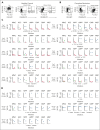Identification and surveillance of rare relapse-initiating stem cells during complete remission after transplantation
- PMID: 38096358
- PMCID: PMC10950475
- DOI: 10.1182/blood.2023022851
Identification and surveillance of rare relapse-initiating stem cells during complete remission after transplantation
Erratum in
-
Dimitriou M, Mortera-Blanco T, Tobiasson M, et al. Identification and surveillance of rare relapse-initiating stem cells during complete remission after transplantation. Blood. 2024;143(11):953-966.Blood. 2024 Jul 25;144(4):464. doi: 10.1182/blood.2024025371. Blood. 2024. PMID: 39052273 Free PMC article. No abstract available.
Abstract
Relapse after complete remission (CR) remains the main cause of mortality after allogeneic stem cell transplantation for hematological malignancies and, therefore, improved biomarkers for early prediction of relapse remains a critical goal toward development and assessment of preemptive relapse treatment. Because the significance of cancer stem cells as a source of relapses remains unclear, we investigated whether mutational screening for persistence of rare cancer stem cells would enhance measurable residual disease (MRD) and early relapse prediction after transplantation. In a retrospective study of patients who relapsed and patients who achieved continuous-CR with myelodysplastic syndromes and related myeloid malignancies, combined flow cytometric cell sorting and mutational screening for persistence of rare relapse-initiating stem cells was performed in the bone marrow at multiple CR time points after transplantation. In 25 CR samples from 15 patients that later relapsed, only 9 samples were MRD-positive in mononuclear cells (MNCs) whereas flowcytometric-sorted hematopoietic stem and progenitor cells (HSPCs) were MRD-positive in all samples, and always with a higher variant allele frequency than in MNCs (mean, 97-fold). MRD-positivity in HSPCs preceded MNCs in multiple sequential samples, in some cases preceding relapse by >2 years. In contrast, in 13 patients in long-term continuous-CR, HSPCs remained MRD-negative. Enhanced MRD sensitivity was also observed in total CD34+ cells, but HSPCs were always more clonally involved (mean, 8-fold). In conclusion, identification of relapse-initiating cancer stem cells and mutational MRD screening for their persistence consistently enhances MRD sensitivity and earlier prediction of relapse after allogeneic stem cell transplantation.
© 2024 American Society of Hematology. Published by Elsevier Inc. Licensed under Creative Commons Attribution-NonCommercial-NoDerivatives 4.0 International (CC BY-NC-ND 4.0), permitting only noncommercial, nonderivative use with attribution. All other rights reserved.
Conflict of interest statement
Conflict-of-interest disclosure: The authors declare no competing financial interests.
Figures







Comment in
-
A road map of relapse in MDS after allo-HSCT.Blood. 2024 Mar 14;143(11):941-943. doi: 10.1182/blood.2023023533. Blood. 2024. PMID: 38483410 No abstract available.
References
Publication types
MeSH terms
Grants and funding
LinkOut - more resources
Full Text Sources
Medical

